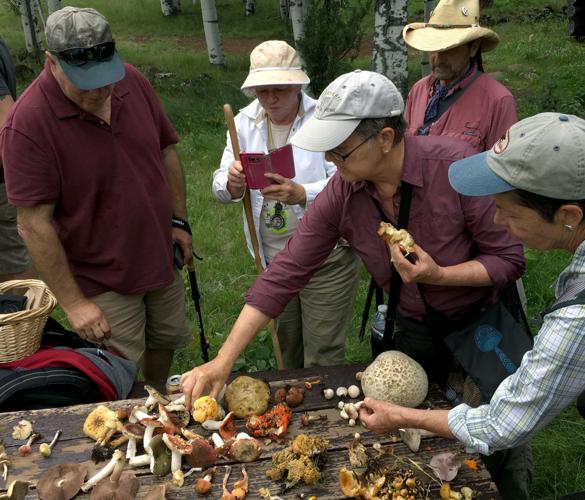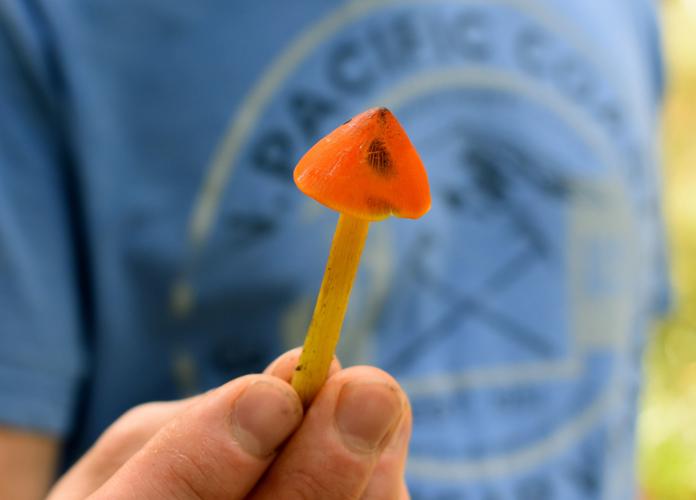Mike Dechter became interested in Arizona’s wild mushrooms on his way to fight a wildfire when he served as a Forest Service firefighter.
“I was dispatched to a snag fire and came across a local in a beat-up old Ford truck picking growler-sized mushrooms,” Dechter said. “He told me they were edible and I should try slicing one and cooking it in butter.”
Dechter, a former biologist, said he later did just that and was hooked, vowing then to learn more about mycoflora, the fungi of a specific region.
He is now the president of the Arizona Mushroom Society, a group interested in mycology, the study of mushrooms. The society holds events ranging from forays to pick wild mushrooms to classes on home-grown mushrooms and making mushroom-themed dinners. The group also works to educate members about the inherent dangers of eating wild poisonous mushrooms and how to properly identify wild edible mushrooms.
Chris May, former Arizona Mushroom Society president, said the group was preceded by the Arizona Mushroom Club, which was founded by Chester Leathers, a professor of biology and mycology at Arizona State University.
“It was just some of his grad students and few folks from the community who decided to look for wild mushrooms together,” May said. “It wasn’t very really big, 50 people maybe, and it was really focused on going to the forest and looking for mushrooms and learning about them.”
May was part of the original club, and said when Leathers retired, about a half-dozen of the club members, including May, decided to establish an Arizona nonprofit corporation. Today, the Arizona Mushroom Society is a registered nonprofit. Leathers is on the board of directors.
The Arizona Mushroom Society has been the state affiliate of the North American Mycological Association since 2001, and has about 380 members throughout the state, May said. Most of them participate in at least two of the dozen or so events the society holds each year.
May said many members are most interested in the “culinary adventure” side, picking edible mushrooms and cooking them, but there are plenty of other reasons to go out looking for mushrooms. Some people like the academic and education aspect of finding mushrooms, and others love to photograph mushrooms.
“In some areas, there’s mushrooms everywhere and they’re very colorful, sometimes it looks like you’re on a coral reef,” May said. “And they’re good candidates to photograph, they don’t fly off like bugs or even sway in the wild like flowers. The joke is that they can hide but they can’t run.”
Dechter originally joined the society to get more information about wild mushrooms.
“I was intensely interested in wild foods, both plants and mushrooms,” Dechter said. “With plants, there is info all over the internet and in books. But with mushrooms, there was limited info on edibility and ID.”
In time, Dechter learned so much about wild mushrooms he started to lead forays to help other members learn.
“Since I lived in Flagstaff, where wild mushrooms can be prevalent, and am an enthusiastic outdoorsman with knowledge of the area, federal rules … and safety protocols, (Chris May) asked if I would be the foray committee chair,” Dechter said.
May said there’s actually very good mushroom habitats in Arizona, especially near Flagstaff and on Mount Lemmon and Mount Graham near Safford.
“Some of them are really choice mushrooms you’d pay a lot of money for at AJ’s or Sprouts,” May said. “When we get up farther north, not the Sky Islands but big forested areas, all that forest around Flagstaff, I estimate that we have about 8 or 10 square miles of decent mushroom habitat for every one of our members.”
May said the foraging season in Arizona is still only about three months long, which means the society has expanded its scope.
“We have historically been more interested in wild mushrooms, but this is Arizona, so we have about a one month season in the spring and two months at the end of summer when the monsoons come, so cultivation is starting to become a little more important in what the club does,” May said.
Dechter said the society is for anyone interested in mushrooms, who wants to learn and contribute to the scientific community.
He said many of the group’s forays and other events are open to just members, which adds to the reasons to join the society.
“The other benefits include being part of a unique and joyous community of interesting and often extremely knowledgeable people who have helped find new species previously unknown to science and donate thousands of dollars to conserve special places.”
Find information online at arizonamushroomsociety.org





